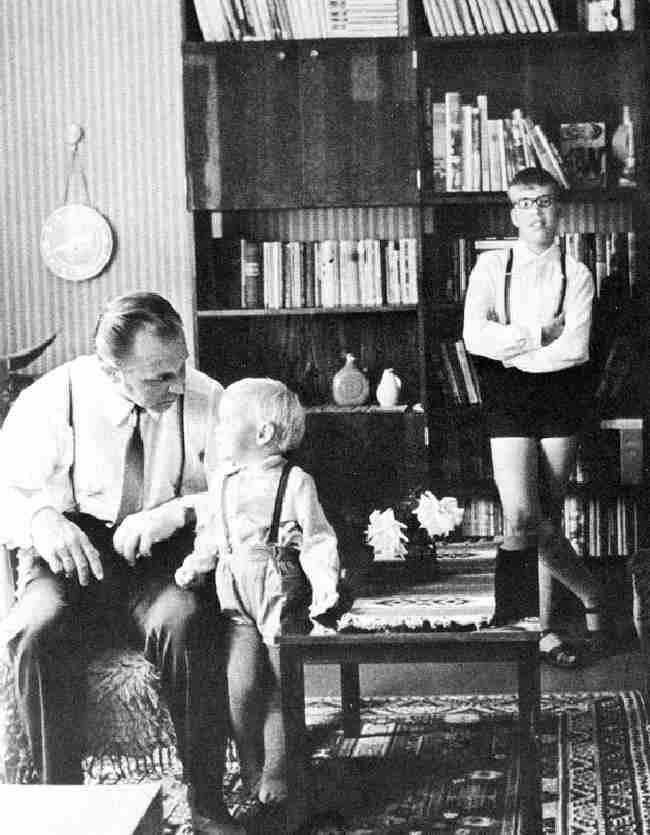
Estonian Boys' Clothes: Families--Captain Uno Kangur

Figure 1.--This is a family photograph, taken in the Soviet Republic of Estonia in 1972. In the photo we see Captin Kangur and his two sons, Tanel (3 years old) and Pryit (11 years old). His wife Malle was a librarian. The family appears relatively prosperous by the Soviet standards of 1972.
|
|
We have little information on Estonian families at this time. We do have information on one family, that of Captain Uno Kangur who was the captain of a Baltic fishing boat. I believe that the family was of Estonian and not Russian extraction. The information comes from 1972 when Estonia was still a part of the Soviet Union.
Captain Uno Kangur
Captain Uno Kangur was I believe of Estonian extraction, not Russian. He was the skipper of a Soviet fishing trawler. The skipper is Captain Uno Kangur who commands a small vessel that traverses much of the Baltic Sea in search of commercial catches of
fish. Kangur's vessel has a crew of five. The ship trawls mainly for the Baltic sprat, a small fish, and in 1971 caught a total of 13,000 tons. Fishermen were a realtively privlidged group in the Soviet Union. They received relatively high wages, especially the captain. Fishermen also had the opprortunity to increases their wages through contacts with the West. This was especially true of the High Seas fleet, but even Baltic Sea boats might pull up along side another fishing boat and engage in barter trade.
Location
The scene is a family living room on the Estonian Baltic Sea island of Hyiumaa. The family lives amongst a community of fishermen known as the Hyiu Kalur fishing
collective. Butter and meat in addition to fish, are the island's main products. In exchange for these, the islanders import almost everything else from the Estonian mainland.
Scene
This is a family photograph, taken in the Soviet Republic of Estonia in 1972.
In the photo we see Captin Kangur and his two sons, Tanel (3 years old) and Pryit (11 years old). His wife Malle was a librarian. The family appears relatively prosperous by the Soviet standards of 1972.
Clothing
The boys' informal
clothes seem to be typical of what was worn by children relaxing at home. Tanel wears a long-sleeved shirt, short pants held up by clip-on elastic suspenders, and either long stockings or tights. Since the family is reasonably affluent and the date is 1972 when tights had just been introduced into the Soviet Union, I suspect that Tanel is wearing tights rather than long stockings although Soviet boys of his age wore both in the early 1970s. Since the stockings worn by children were knit long enough to
cover almost the entire upper leg, it is often difficult to tell whether stockings are tights are being worn. The tights of course were more expensive. Pryit, the 11-year-old, wears a white shirt without a tie buttoned at the neck and quite briefly cut shorts held up by rather thin clip-on elastic suspenders. This type of clip-on suspenders had become fashionable among men and boys in various parts of eastern Europe. Notice that Dad wears the same kind of suspenders as his two sons. Pryit wears leather sandals with neither socks nor stockings.
HBC

Related Chronolgy Pages in the Boys' Historical Web Site
[The 1880s]
[The 1890s]
[The 1900s]
[The 1910s]
[The 1920s]
[The 1930s]
[The 1940s]
[The 1930s]
[The 1940s]
[The 1950s]
[The 1960s]
[The 1970s]
[The 1980s]
Related Style Pages in the Boys' Historical Web Site
[Smocks]
[Long pants suits]
[Knicker suits]
[Short pants suits]
[Socks]
[Eton suits]
[Jacket and trousers]
[Trouser suspension]
[Blazer]
[School sandals]
[School smocks]
[Sailor suits]
[Pinafores]
[Long stockings]
Navigate the Boys' Historical Clothing Web Page
[Return to the Main Estonian country page]
[Introduction]
[Activities]
[Biographies]
[Chronology]
[Clothing styles]
[Countries]
[Bibliographies]
[Contributions]
[FAQs]
[Spanish glossaries]
[Satellite sites]
[Tools]
[Boys' Clothing Home]
Created: April 8, 2004
Last updated: April 8, 2004



